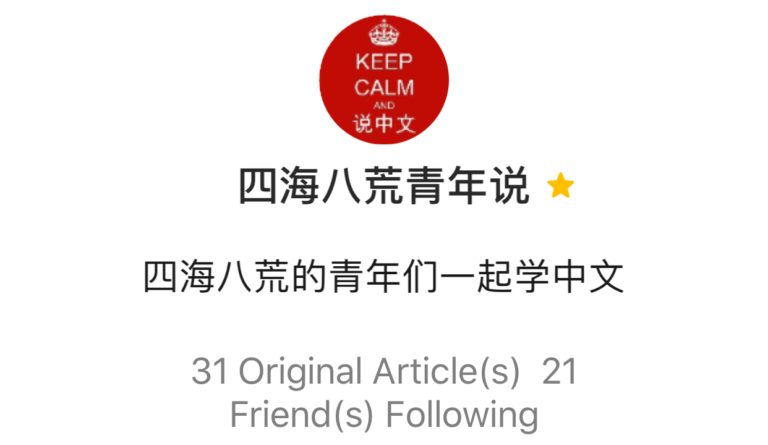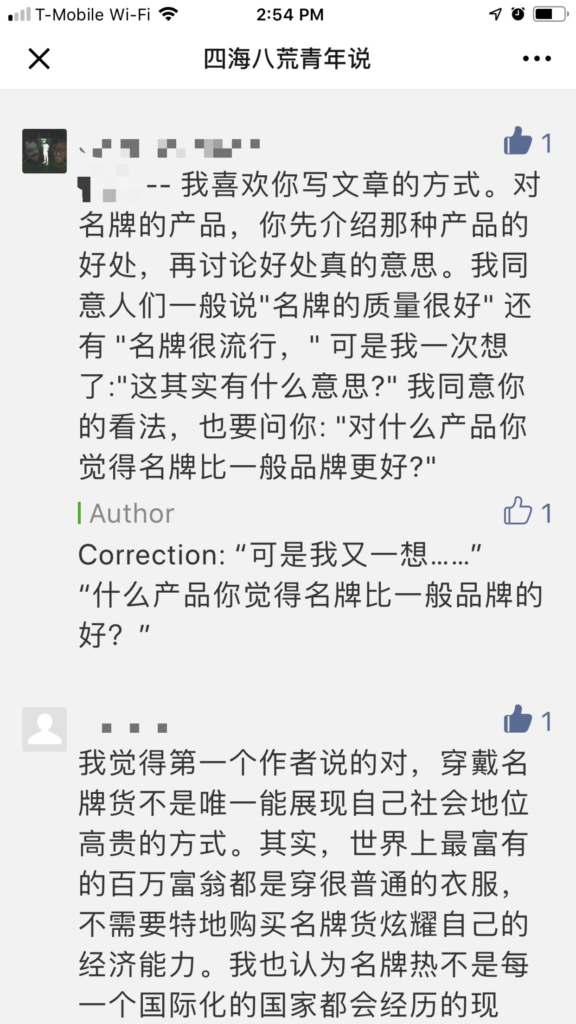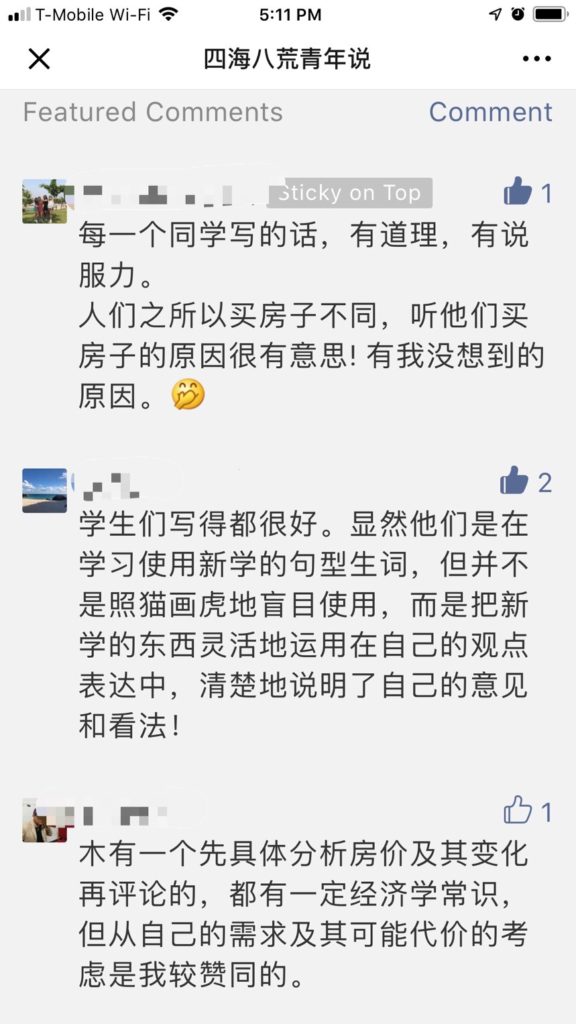Background
On the first day of Chinese class, teachers sometimes tell their students that Chinese is easy to learn, but this is often not true in practice. According to the Defense Language Institute, Chinese is one of the “Category IV” languages, which are exceptionally difficult for English speakers and require longer hours to meet the same proficiency standards as those of other languages. Due to time constraints, language teachers are continually looking for ways to use class time more wisely while promoting students’ autonomous learning outside of the classroom.
These challenges prompt an underlying question: how can educators encourage their students to engage in meaningful language learning outside of the classroom, thereby freeing up valuable class time for deeper discussions and better practice? Social media offers potential solutions to this challenge. The popularity of established social media platforms allows millions of users to interact and communicate with each other, no matter where they are and what they do. This connectivity makes it ideal to support pedagogical objectives of enhancing foreign language application in and outside of the classroom and connecting students to each other and to native speakers.
Using social media in the college language classroom is not a new concept. A cursory Google search will yield a multitude of ideas and top tips for Twitter and Facebook use in academic settings, and academic journals have also started publishing literature on social media pedagogy. However, little is known about its affordance in Chinese for second language education. A limited number of studies that primarily focus on using the instant messaging or group chatting functions of social media to teach spoken Chinese have been published (Jin 2018; Li 2016; Luo and Yang 2016; Wang, Fang, Han and Chen 2016), but how to effectively integrate social media in teaching Chinese writing remains a question.
In the spring 2018 semester, I began using social media in my Advanced Chinese I class. This class met twice a week and all 16 students were native English speakers and they had just finished their second year of Chinese study at New York University. The aim of this project was to build a virtual learning community using WeChat, a social networking mobile app popular in China, to promote students’ interest in writing in Chinese, provide a broader audience, enhance their vocabulary and grammar, and offer more opportunities for collaboration, interaction, and feedback. Since WeChat has become so ingrained in Chinese society, this project also added target cultural elements into students’ learning experience.
Implementation
I created a WeChat official account called “四海八荒青年说(World Youth Forum)” (Fig. 1). A WeChat official account is a subscription account, which is much like a daily news feed that allows account administrators to push one new update a day to their followers (Fig. 2). Students can subscribe simply by scanning the QR code using their smartphones.

Figure 2. A screenshot of the timeline of the WeChat official account. We can push one new update a day to the followers. This could be a single article or multiple articles bundled together into one larger update.
During the semester, students submitted their daily writing assignment related to classroom readings. Writing assignments could include short responses, essays, or short stories. This is our weekly schedule (Fig. 3):
During this particular week, the textbook reading was “Brand-name Fever”. Therefore, the daily writing prompts student received were all related to that topic and they were also required to use certain new vocabulary and grammar patterns in different scenarios. Students submitted their handwritten homework (Fig. 4). At this stage in their Chinese learning, it is still very important for students to practice character writing.
Each week, I selected one to three samples of student writing, added some fun pictures, then published them on WeChat (Fig. 5). Teacher feedback and error corrections were also posted along with students’ original writing so they could compare (Fig. 6).

Figure 6. A screenshot of teacher feedback and student original handwritten homework with error corrections posted along with the article on the WeChat official account.
Students were then asked to read and provide constructive feedback to their peers’ posts, while the published students were also asked to respond in kind (Fig. 7 and 8). In class, students would use their posts as a draft for an oral presentation.
Because this learning community was open to the public, we received comments from teachers and Chinese learners from other universities, and native Chinese speakers from all over the world (Fig. 9). In this way, students got authentic language input and some of them were even able to engage in conversations with native Chinese speakers on WeChat.
By the end of the semester, I edited and produced a student journal comprised of the WeChat posts, titled A Collection of Essays on Social and Cultural Change in China, and each student received a physical copy (Figs. 10 and 11). It was a surprise, so when students got the magazines, they were very impressed with how much we had covered in one semester.

Figure 10. Pictures of the student journal: A Collection of Essays on Social and Cultural Change in China, Spring 2018.
The first pilot in the spring yielded encouraging initial results, so I decided to test with a different student population in the fall for the second iteration. In the first pilot, I found students did not contribute equally. Therefore, in the second round, I made the peer review activity mandatory and the uniform participation helped foster a more vibrant learning community. This time we received more comments for each post (Figs. 12 and 13).
This time we also held a seminar to celebrate the publication of the journal and share learning experiences. At the event, each student read excerpts of their favorite essays and shared the struggles and triumphs in their Chinese learning.
Student feedback
Students were also given a feedback survey in which they self-reported their level of satisfaction and perceptions of learning as a result of the WeChat project (Table 1). Students’ survey responses showed that the project was generally well received, and they reported five major benefits: Expansion of learning time; feedback from diverse audience; collaborative learning; reinforcement of vocabulary and grammar; and enhancement of learning motivation.
Table 1. Student perspectives on WeChat project.
| Benefits | Examples of students’ responses |
| Expansion of learning time | “We can do it on our own time.”
“I can read the posts more than once.” “ I appreciate the opportunity to interact with other students outside of class through WeChat, because it allows us to use the language more authentically.” |
| Feedback from diverse audience | “It was fun to see other students’ comments while also practicing reading and writing.”
“Exposure to native speakers and their content online.” “You (teacher) offer to correct our posts, that helps a lot.” |
| Collaborative learning | “I think it was insightful to see how other people used the language, such as grammar and vocabulary.”
“It allowed me to view other peers’ writing that was close to my own level.” “I enjoyed seeing the ways other students responded to the writing prompts.” “It really helped me with the review. It’s efficient and not time-consuming.” |
| Reinforcement of vocabulary and grammar | “I thought it was a good way to practice through the vocabulary in a text form, because the book doesn’t give too many examples.”
“There was a lot of materials and resources on the account so a lot of opportunities to read and review. It was also interesting just to read other people’s essays and see the topics from different perspectives and insights.” “I liked being able to see the words we learned in each unit being used in other contexts because it showed me various applications of the words we learned.” |
| Enhancement of learning motivation | “It gave me confidence when my work was showed. The account also motivated me to put extra effort into my writing.”
“I like that it made our material more interesting because the social media aspect made it more lively and less like homework.” “I had never used this app before so it was interesting seeing its different functions and it was especially cool that it could be used to enhance my Chinese learning.” |
Based on the results of the survey, this project expanded students’ study time. Once they had access to the knowledge, they could learn at their own pace by reading the articles as many times as they want. The external audience of Chinese language speakers provided by WeChat motivated students to do their best work. Since students did not want to be seen as poor writers by their peers, they performed at a higher level when they knew their work will be shared. Also, writing for a larger authentic audience made them more thoughtful in their vocabulary and more willing to provide detailed explanations.
The survey results also indicated that the project helped build community while providing opportunities for peer instruction. Many students found it helpful to see how peers wrote and used the vocabulary and grammar in different and creative ways. Multiple students’ survey responses noted how their peers’ writing also served as level-appropriate reading material, which reinforced learning through multiple readings.
Furthermore, students indicated that seeing their own work published increased their motivation, making them more confident during classroom discussion. It also prompted them to put extra effort into their writing. Some students liked the social media aspect because it created a stress-free learning environment and made the peer review activity “more lively and less like homework.”
Our posts received a lot of encouragement and positive feedback; however, there were also some dissenting voices. Some students complained about the extra time and extra work, and the unequal level of contribution was also noticed. Interestingly, several students commented that native speakers’ comments were not particularly helpful, which is perhaps counterintuitive. One might assume that the students study Chinese to communicate with native Chinese speakers. However, it turned out native speakers’ language was sometimes too advanced for students to understand, as indicated in the comment below:
Native speakers’ comments were simply too native and too hard to understand.
They are not really feedback, more like encouragement.
Lack of knowledge about my students’ level of proficiency lead to some native speakers’ inappropriate expectations about the content and language use in students’ writing. Sometimes native speakers were sarcastic or overly critical in their comments, which might be considered intimidating or counterproductive. Luckily, WeChat gave me a useful superpower. As the account administrator, I could selectively allow comments that provided real critique and feedback to be visible on our WeChat account.
Teacher reflections
This year-long project helped me gain insights into social media use in second language teaching. Based on these experiences, I believe that with the appropriate structure, a social network can also be a learning network (Bruff, 2011). Productive educational use of social media can provide a back channel for the students to stay connected to the course and their peers during the semester and even after course completion. It is also helpful to bridge the social distance between educators and students, increase teacher contact time, and strengthen teacher-student relationships.
Before rolling out this project, I considered various platforms and evaluated which would be most suitable for the assignment. I found that WeChat incorporates some of the best elements of a myriad of social networking apps and platforms and puts them into one package. Although WeChat started as a mobile instant-messaging app, it quickly added many other social, discussion, and blogging features. Specifically, I chose to make a WeChat official account for this project, which is the WeChat equivalent of a Facebook page where the account administrators can broadcast blog posts to their followers, which allowed students to create and revise detailed posts before publishing them.
During the project, I discovered more features of the WeChat official account that were beneficial to the class. I quickly found that a WeChat official account is much better suited for richer and longer discussions than Twitter and other microblogging platforms, which are better for informal exchanges. In this project, the main goal was to encourage students to use specific structures and precise vocabulary on topics related to classroom readings. Students were also expected to provide well-supported arguments, including detailed evidence in support of their viewpoints. With WeChat official accounts, like WordPress or Medium, there is no limit on the length of the posts, so I can encourage my students to write more in-depth articles. As the class worked on their articles, we found that WeChat posts work best when they include rich media, multiple pictures, videos, and polls, along with the text. Another benefit is that students do not need separate applications to view content and participate, as the official account is visible publicly. This also makes it convenient for both current and incoming students to find, read, and review posts and comments. Twitter can also group topics using hashtags, but this can be confusing for students, especially if they have little background in technology. Further, overwhelming information and irrelevant posts on Twitter and Facebook can serve as a distraction. More importantly, WeChat allows the account administrator to have more control, which made it easier for me to closely monitor students’ progress, and provide timely guidance and feedback.
With Twitter and Facebook’s increasing popularity, many teachers have discovered an increasingly ambiguous line between formal and informal language use in students’ writing assignments. I designed this project with the goal of teaching students how to use formal vocabulary and more complex sentences to produce full paragraphs that are organized and detailed. In order to improve the accuracy of their writing, I wanted to regularly expose my students to good writing, essays without improper use of the target language or grammatical irregularities, and motivate them through positive reinforcement. Unlike other social media apps or blogging sites where users can post without pre-approval, WeChat gives the official account administrator the ability to selectively allow posts and comments. In the peer review activity, this function was very helpful for me to increase students’ language awareness and encourage them to self-correct their own writing. For students who have clearly not grasped the target language structures, I could reply privately to their peer review comments with grammar error correction feedback without posting their comments, so other students would not get confused. I also used this function to block inappropriate or irrelevant comments and to make sure there were no digressions or unanticipated shifts in topic.
In this project, I wanted to connect my students to other Chinese learners and native speakers to provide them with a broader audience. Since WeChat has become so ingrained in Chinese society and Chinese-speaking communities around the world, it serves the purpose much better than any other platforms. Many other apps or websites, like Twitter, Facebook, and WordPress are not available in China, which would make reaching a Chinese audience virtually impossible. Additionally, using WeChat for this assignment added target cultural elements into students’ learning experience. Many of my students are planning to study in China in the future, and they are already familiar with different features of WeChat.
Writing in Chinese can be difficult for my students, but WeChat provides access to content outside of the classroom in a low-stakes environment that promotes independent learning. Blended with classroom discussions and presentations, it can enhance students’ overall learning experience and satisfaction. When I designed this assignment, I did not use WeChat because it is a “cool tool”, but because it suited the educational goals of this project.
Conclusions
The results of the current WeChat project are very positive. Although this paper is based on a small-scale study, it has provided evidence that in a foreign language course, with careful design, WeChat can extend students’ learning beyond the classroom walls, strengthen ties between students, and develop their audience awareness. As the impact of social media on language and culture becomes more pervasive, it is my hope that other educators will start experimenting with social media pedagogy in their language courses. More research and practice may shed new light on social media use in language teaching in the future.















'A Learning Success Story with WeChat' has 1 comment
December 6, 2019 @ 10:31 am A Digital Scholarship Smorgasbord: Assignments, Blueprints, Reviews, Teaching Fails, and Tool Tips at JITP – GC Digital Fellows
[…] a more digitally sophisticated teacher. Some especially interesting posts include Chen Gao’s “A Learning Success Story with WeChat,” which discusses how the author used China’s most popular social networking app, WeChat, to […]